
Years ago, I rushed one of my aging girls to the vet because of her persistent cough. Concerned it might be pneumonia, I prepared for the worst and an overnight stay. Thankfully, my vet, known for his practical approach, performed an X-ray while she was awake and diagnosed her with a manageable heart condition. It was a relief! What surprised us both was the discovery of full arthritis in her spine, despite her trotting in and wagging her tail happily. I mentioned she'd been on a Golden Paste, a turmeric supplement, for 18 months, and he exclaimed we absolutely must continue because it seemed remarkably effective!
All dogs need extra care as they age. But Bulldogs, in my experience, can seem to age almost overnight. Therefore, maintaining their activity levels is vital for their overall health and happiness. In this blog, we'll delve into why keeping Bulldogs active is so crucial and ways you can support their mobility and comfort. ★ The Importance of Keeping Bulldogs ActiveBulldogs may not be the most energetic breed. Still, regular exercise is vital to prevent obesity, support joint health and maintain muscle tone (the breed standard states that a firm muscular condition is highly desirable). Here are some reasons why keeping your Bulldog active is essential:
★ Recommended Activities for BulldogsWhile Bulldogs don't require intense exercise, incorporating moderate activities into their daily routine can make a big difference…
★ Joint Supplements for BulldogsAs Bulldogs age, they may benefit from joint supplements to support their mobility and reduce discomfort. Here are some of my highly recommended joint supplements:
★ ConclusionKeep an eye on your Bulldog aging, so you can take proactive measures to help your Bulldog live a long, healthy, and joyful life! Always consult your vet or a canine nutritionist if you are concerned about the impacts of any supplements.
But as our Bulldogs age, they become the Princess in the fairy tale. It becomes crucial to monitor their health closely and make necessary adjustments to ensure they remain comfortable and happy. Like all senior dogs, ageing Bulldogs can experience various age-related issues that may require changes in their care routine. These small changes can significantly impact their well-being, from softer bedding to dietary adjustments. So, given the fairy tale, let's look at bedding first! Comfort and Bedding One of the first things to consider is their sleeping arrangement. As dogs age, they can develop bald spots on pressure points, joint pain, and arthritis, making it crucial to provide a comfortable place to rest.
Diet & Nutrition As Bulldogs age, their dietary needs change. Ensuring they get the right nutrition is vital for maintaining their health and preventing common issues like obesity and digestive problems.
Joint Care & Mobility Joint issues are common in senior Bulldogs, so it's important to take steps to support their mobility and ease any discomfort they may experience.
Grooming & Hygiene
Regular Vet Check-Up One of the most important aspects of caring for a senior dog is ensuring they receive regular veterinary care. Frequent check-ups can help catch potential health issues early and allow for timely intervention.
Environmental Adjustment Making minor changes to your home environment can significantly improve your Bulldog's quality of life.
By making these thoughtful adjustments and providing attentive care, you can help your ageing Bulldog enjoy their golden years with comfort and happiness. Check out my other blog posts for more detailed tips on senior Bulldog care.
Have you ever been captivated by Bulldogs' endearing wrinkles and charming snorts, only to wonder what's behind their cute exteriors?
If so, you're not alone. As a dedicated Bulldog enthusiast, I longed for a platform where I could delve deeper into the realities of this beloved breed, sharing authentic insights with fellow admirers, owners, and breeders around the globe. This longing gave birth to the Bulldog Broadcast, a podcast dedicated to exploring the true essence of Bulldogs beyond the stereotypes and misinformation. The Inception of Bulldog Broadcast
As the host of the Bulldog Broadcast, my journey with this podcast began somewhat serendipitously. During a scroll through a Facebook group, initially joined out of curiosity rather than active participation, I stumbled upon a post asking for advice on Bulldog puppies. The comments section was rife with misinformation and negativity about Bulldogs, portraying them as fragile and unhealthy.
This frustration sparked an idea: rather than engaging in a futile online debate, why not create a positive, informative space dedicated to Bulldogs? A podcast seemed the perfect medium to reach a wider audience, dispelling myths and offering real-life insights into Bulldog ownership and breeding. Addressing the Stigma
Bulldogs often face unfair stigma, mainly pedigree and brachycephalic (flat-faced) breeds. Critics claim they are prone to health issues and have short lifespans. As someone who has lived with and loved Bulldogs for over three decades, I felt compelled to address these misconceptions.
Why would I, a reasonably sensible person, choose to breed dogs supposedly "on death's door"? The truth is, with responsible breeding and proper care, Bulldogs can live healthy, fulfilling lives. This podcast highlights responsible breeders, dedicated owners, and real Bulldog stories that showcase the breed's resilience and vitality. My Bulldog Journey
This extensive experience has taught me that while Bulldogs are unique, requiring special care and understanding, they are incredibly rewarding companions. They are not just pets; they are little personalities wrapped in dog bodies, full of character and charm.
What to Expect from the Bulldog Broadcast
The Bulldog Broadcast is designed to cater to prospective and current Bulldog owners. We'll cover topics such as:
✅ Identifying Reputable Breeders: Tips for finding ethical breeders dedicated to the health and longevity of the breed. ✅ Bulldog Care and Responsibilities: Practical advice on caring for Bulldogs, understanding their unique needs, and ensuring they lead happy, healthy lives. ✅ Dispelling Myths: Addressing common misconceptions about Bulldogs and sharing success stories from long-lived, healthy Bulldogs. ✅ Interviews and Insights: Conversations with breeders, rescue workers, and Bulldog enthusiasts who have significantly contributed to the breed. Join the Community
The Bulldog Broadcast is more than just a podcast; it's a community. Alongside each episode, you'll find show notes and resources on our website, Bulldogbroadcast.com. I also invite you to join our Facebook community, where you can ask questions, share your experiences, and connect with fellow Bulldog lovers.
Spread the Word
While most podcasters ask for ratings and reviews, my primary request is simple: tell two people interested in Bulldogs about this podcast. By spreading the word, you help build a knowledgeable and supportive community dedicated to the love and welfare of Bulldogs.
Signing Off
Thank you for joining me on this journey, you can listen on any podcast streaming platform. I hope the Bulldog Broadcast becomes a valuable resource for you, offering insights, support, and a sense of community. Whether you're a seasoned Bulldog owner or considering bringing one into your life, this podcast guides and inspires you.
So, stay tuned and let's celebrate everything that makes Bulldogs truly special. Ta ta for now! … and what it means for Puppy seekers!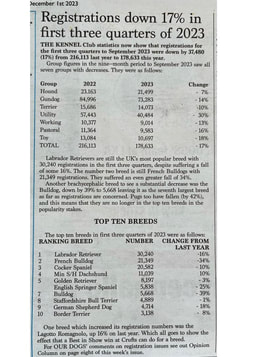 CLICK TO ENLARGE CLICK TO ENLARGE The Kennel Club published their 3rd quarter registration stats this week, and puppy registrations are down by 17%. Even more surprising, Bulldogs are down by a whopping 39%, the second* most significant drop in the top ten most favoured breeds to under 6,000 born up to September 2023. To give you an idea, there were over 21,000 French Bulldogs registered and over 30,000 Labradors - crazy numbers. Remember, many popular 'fad and fashion' dogs can’t be KC registered because of their coat colour or type (which means they aren’t purebred) and don’t get me started on the XL bully ban. American Bullies are ABKC reg, and their number is unknown in this country - but it’s A LOT. Now, this isn’t a bad thing, in my opinion. Far too many puppies have been bred for a quick buck since the pandemic, so it’s good to see it normalise again. Also, global economic pressures were always going to impact demand. And I’m sure the rescue and rehome charities are singing their praises for the decline. But it also means that buying a well-bred, quality Bulldog puppy is harder than ever. Any breeder that’s worth their sort will have a waitlist, so if you want to add a puppy to your family any time soon, make sure you get on a list and be prepared to wait. * Pugs dropped by 42% and are no longer in the Top 10. Sara's Canine Curated Essential Supplements Shopping List📃
Top Travel Tips for Bulldog Owners on the Go🚦
I was sent this intriguing study printed in the Telegraph that I think you'll find absolutely adorable. Researchers have found that our fascination with flat-faced dogs like Bulldogs, Pugs, and French bulldogs is due to their uncanny ability to tug at our heartstrings like babies. I've struggled to believe this because anyone who knows me knows my 'baby interest' is absolutely zero. Coo, I do not. These brachycephalic breeds, known for their cute, baby-like faces and large eyes, have been gaining popularity for decades. According to the study from Hungary, their helplessness is the key. When faced with a problem, they're more likely to seek help from humans rather than solve it themselves. I was dumbfounded by the above, but it's most certainly true from my years of experience, and I even wrote about my IQ and EQ differences with my Bulldog vs. Labrador emails.
 ⬆️ This is Captain Biggles (2023) ⬆️ This is Captain Biggles (2023) The study suggests that this behaviour increases the bond between humans and these cute canines, making us feel more attached to and dependent on them. It's almost as if they've evolved to trigger our nurturing instincts. And here's the kicker: While some may argue that Bulldogs are less independent, the researchers suggest they've mastered a different strategy. They use their "baby-like" behaviour to get humans to solve their problems. Pretty clever, right? So, the next time your bulldog looks at you with those big, innocent eyes, remember they're just tugging at your heartstrings with their irresistible charm! Introducing LaRoyal's comprehensive new puppy shopping list – your ultimate guide to preparing for your furry friend's arrival! We understand that bringing home a new puppy is an exciting and joyful experience, and we want to ensure you have everything you need to provide the best care. This meticulously curated list includes all the essential items to cater to your puppy's needs, from feeding and grooming to comfort and safety. With this shopping list, you can rest assured that you won't miss a thing. Be equipped with top-quality food, water bowls, a cozy bed, durable toys, grooming supplies, training essentials, a secure leash and collar, and much more. I've taken the guesswork out of the equation, enabling you to focus on creating a warm, loving environment for your new furry family member. Start your puppy parenthood journey right with our indispensable shopping list and give your puppy the best start in life. Shopping ListThis is shopping list has direct links to Amazon. For transparency, we participate in the Amazon Services LLC Associates Program, an affiliate advertising program designed to provide a means for us to earn advertising fees by linking to amazon.co.uk and affiliated websites. Bedding
Collar & Lead
Grooming
ToysNo thin plastic ‘squeaky’ toys or cowhide chews.
Health Supplements
Feeding
Miscellaneous
Bulldog Broadsheet: Connecting Bulldog Lovers - Your Go-To Newsletter for a Pawsome Community!14/7/2023
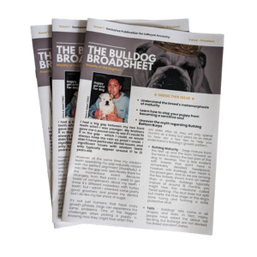 Issue 1 Issue 1
As a passionate and dedicated bulldog breeder, I am delighted to announce the creation of an informative and engaging 8-page paper and ink newsletter. This initiative is aimed at providing valuable resources and fostering a sense of community among interested puppy buyers, existing dog owners, and individuals whose dogs' ancestry is connected to the LaRoyal kennel.
My decision to embark on this venture stems from a deep-seated belief in the importance of education and support for bulldog enthusiasts. Bulldogs, with their distinctive appearance and unique characteristics, have captivated the hearts of many, and I recognise the need for a comprehensive platform that promotes responsible ownership and celebrates the breed's rich heritage. Through the Bulldog Broadsheet newsletter, I strive to empower puppy buyers by equipping them with the knowledge and tools necessary to make informed decisions when selecting a bulldog companion. I will share insights on breed standards, health considerations, and reputable sources for acquiring healthy puppies. By providing this information, we hope to contribute to the responsible breeding practices that are essential for the well-being and longevity of the breed. Moreover, I am committed to supporting existing bulldog owners throughout their journey. LaRoyal's Bulldog Broadsheet will address common challenges faced by bulldog owners, offering practical tips on training, grooming, nutrition, and health maintenance. By sharing experiences and best practices, I aim to create a community of support, enabling owners to navigate the joys and responsibilities of bulldog ownership with confidence. Furthermore, I recognise the significance of preserving the ancestry and history of bulldogs. Many individuals own bulldogs with fascinating lineage connections, and we intend to highlight these stories in our newsletter. By exploring the breed's past and present, we hope to deepen the appreciation for bulldogs as a cherished part of our cultural heritage. My decision to create an 8-page paper and ink newsletter for bulldog enthusiasts is driven by our dedication to fostering a sense of community and providing comprehensive education. My aim (and hope) to empower puppy buyers, support existing owners, and celebrate the breed's history. By doing so, we hope to enhance the lives of bulldogs and their human companions, ensuring a bright future for this remarkable breed. Together, let us embark on a journey of learning, growth, and camaraderie within the bulldog community. 30th June 2022 BULLDOG - Judge: Miss Sara Lamont Best Of Breed & Best Puppy: 1292 Handley's Haddaway Hey Bulldog Dog CC: 1292 Handley's Haddaway Hey Bulldog Res Dog CC: 1311 Reynolds D'or Wood San Valero At Gratiabull Bitch CC: 1281 George's Avaword Dottie Res Bitch CC: 1325 Vaughan's Ch Odinschild Violet Princess JW SHCM Best Veteran : 1293 Hanley’s Ch Sgribble Pip As Blenhiemstar Having not been ringside for three years, it was nice to see the dogs with fresh eyes. Overall the quality was more consistent in the females than in the males, though I was pleased with my final winners. I thoroughly enjoyed the appointment and thank my stewards for ensuring the ring ran smoothly. I don't think I've ever experienced rain before at this venue, but there is always a first. The dogs, particularly the females (and their handlers), coped exceptionally well with the thundery rain.
There's no doubt that the show dogs are the healthiest they have ever been, and breeders should be applauded for such significant developments in the Breed's health. I feel that the Bulldog head, particularly the overall size and correct shape, is being lost, and even more so the grand width of the jaw. There are modern reproduction techniques nowadays, and I encourage more breeders to be freezing semen and use the frozen available to help claw back some of these essential breed assets, where possible. VD/B (4,1) 1st PARKER'S ALBIONPRIDE A KING OF MAGIC JW, Masculine F/W, to who I have previously awarded the RCC. 7 years old, and great to see him age so well. Large, clean head with no excessive wrinkling. Had the widest jaw of the day, a feature we breeders must do more to preserve. Great body condition, well-toned with no apparent skin callus' that normally comes with age. Large framed with good bone and tidy feet given age. Good rear angulation moved soundly with a wide true front. Was unfortunate to come up against 3rd in OB to miss out on BV. 2nd COLLINS & GILLINGWATER LINFORDPRIDE JUNO ECLIPSE SH.CM, 8 years and 10 mth old white bitch. Feminine head that was well pigmented. Coat in good clean condition with a cobby and short body, filled with prominent ribs. Enough bone, moving soundly with width to her front. 3rd COLLINS & GILLINGWATER LINFORDPRIDE MAMA THE HUTT MPD (4,2) 1st RODGERS BELUSHI ONE IN TEN, Deep red with well-pigmented eyes and muzzle with the correct rose ear. Won the class on length of skull and overall head proportions. Shapely body with wide front, good bone and compact feet. Short coupled with good topline. Moved soundly. 2nd BRAGGER PRIDEOFBULLY MAGIC MIKE, R/W also with great pigmentation. Strong bone, with a wide front giving a pleasing front appearance when stood. Shapely body, well-laid shoulders, good rear angulation and pleasing tail. A little loose in movement, but acceptable given age, moving soundly. PD (3,0) 1st HANDLEY HADDAWAY HEY BULLDOG, what a handsome boy who took my eye immediately. 10mth old Br/W whose headpiece is as clean as a whistle. Beautiful head proportions, broad flat skull, correctly set thin rose-shaped ears. Eyes set wide apart that are dark, round and clear. Full nose roll not obstructing his nose or layback over a big, black nose with wide nostrils finished with good width of jaw, well-fitting and nicely covered flews. Correct arch of shoulders, to thick well, boned forelegs, strong pasterns and tight cat feet. Enough rib for maturity, giving the correct pear shape with a suitable rise in topline with a low tail set and sufficient tail. This boy moved with ease, covering the ground well, correctly walking his width. Awarding such big awards to a young dog is always a statement, but this boy is beautiful and seems to have a well-developed but not excessive growth pattern. I think (from my observation) he will mature beautifully, ensuring a big, bright future ahead of him. I was happy to award him the CC, BOB & BP. He wasn't placed in the groups, but watching the footage online, he showed well for such a big demand at such a young age, and I rarely see two brachy breeds shortlisted as this level with the French Bulldog taking G2. I will enjoy seeing how this boy powers through the rest of 2022. 2nd MAY SIR DONALD THE BOLD, 10mth old Short and cobby r/w. Good head qualities, broad skull, correct set of ears and low eye set. Big clear, dark eyes, full nose roll over a big black nose. Enough turn of jaw and width. Strong bone of forelegs with good cover of body condition and coat. Moved soundly. 3rd IRONMONGER MYSTYLE RED ENSIGN TAF JD (1,0) 1st GILLETT MIREMAN NANO FOR ONABAZZ, Stood alone but more than deserving of this placement. Br/Pied 16mths. Short bodied with big ribs and correct topline and tuck-up. Strong, thick forelegs to compact feet giving a pleasing front. For me just lacked a little maturity; the foundations are there with a good length of skull, dark pigmented muzzle and correct rose ears. I would also start to tone up his body condition, so he's a little tighter in his coat. He moved well and soundly with good front width and rear movement. YD (4,1) 1st WARE DISCOBULLS RENEGADE MASTER, 16mth R/W and what a powerhouse. This boy is all male and some. Masses of bone, a solid frame with well-laid shoulders, straight bone to strong pasterns and tight feet. Quality traditional headpiece with good length of skull, width throughout the skull and width of jaw. He would be a little more balanced if he was more filled behind the shoulders and a tad shorter in body, but he has the rise of topline and low set tail of good length, which was free moving. No doubt this is a quality boy carrying essential stud assets. 2nd BRIDDON MIRISTAR ROCYN REBEL, 16mth plainer headed than 1 but an appealing, clean upstanding male. Flat classic skull, no excessive wrinkling in the head, well-rounded cheeks with good width throughout the skull. Well-boned front, good neck length into well-laid shoulders and big ribs. Short in back with the correct topline and good rear angulation. 3rd FOWLER KADREYA GALANTIS PGD (4,0) A challenging class to judge that varied in size and type. 1st GOODWIN BRITISHPRIDE ROCK AND ROLL, R/W won the class on overall balance and proportions. Had enough of everything to provide a pleasing outline and the best breed type in the class. Clear, dark eye, well-pigmented muzzle, good-sized nose with good fit and turn of jaw. Enough rib gives a pear-shaped body, with the rise of topline and good tail. Moved soundly. 2nd BROOKS MIGHTY KING ARTHUR, a large solid white. A tad too big and heavy for me, with excess skin. Strong bone filling his fame, he moved well for this size. Large head size, eye set well part and low what were dark and clear. Well padded muzzle with a true jaw that fitted well. For me, he needs to lose a few lbs and tone up in body condition. 3rd SMITH LADYMERE KINGSTON LD (8,2) 1st REYNOLDS D'OR WOOD SAN VALERO AT GRATIABULL is a slightly understated dog at first glance, but the more you look, the more you like. A clean r/w masculine boy with suitable work in his head. Broad skull, neat rose ears, well-pigmented eyes and muzzle with well-filled cheeks. Big nose with a full nose rope, not impeding layback. Enough width of jaw with good fit and turn. Strong bone to strong pasterns and neat compact feet. Excellent overall proportions, with a wide front, good ribs and a narrow waist giving the correct pear-shaped body with the correct topline and sufficient tail. He was the best mover in the class and cruised to the RDCC in the challenge. 2nd CUNNINGHAM SAFFIENNA GYPSY KING, a similar type to 1, R/W with a classic clean head. Great length of skull and square throughout. Well-boned straight front, shapely body that could carry a little more weight to balance him out. Lost out to 1 on feet but moved ok. 3rd EVISON ANDLARE SCOOTER AT KIKUCHI JW OD (9,3) 1st BRAGGER PRIDEOFBULLY NIGHT FURY, R/w Pied. Clean and honest boy. Well-boned, strong pasterns and compact feet with depth of brisket providing a pleasing front. Amazing pigment with dark wide-set eyes, enough work in the skull with neat rose ears. Shapely body, correct rise of topline finished with a good tail. One of the few to have the correct Bulldog roll whilst moving and won the class on movement. Considered for the RCC. 2nd GEORGE AVAWORD KING GEORGE, R/W with strong bone and neat feet and I believe litter mate to the BCC and carrying very similar properties. Compact size and short coupled with big ribs and short back. Ok tail. Good bone with sufficient front feet. Head a little heavy, but good width and turn of jaw. 3rd MARTIN CALIBRA PEPSI MAX GCD/B NO ENTRIES MPB (4,1) 1st CUNNINGHAM ANZABULLS ULTRA VIOLET NAF TAF, 8mth ticked white thick girl. Deep chested with excellent depth of brisket. Well-boned with compact feet. Flat, broad skull, good ear set and rosed ears. Nice dark pigment with a clear eye and big nose, creating the correct layback. Moved very well for age, a very plump girl with beefy thighs, but even for a puppy, she carried too much weight. A few lbs off will help her overall leg length/body proportions. 2nd RODGERS BELUSHI MOONLIGHT LOVER, Deep R/Br and white with a totally different frame to 1. This girl is yet to blossom and mature, but for MPB, rightly so. Clean skull with good length and nice fit and turn of jaw. Good width of chest with straight bone. She was short-bodied with rounded rib, good rear angulation, and moved well once she settled with her gait. 3rd GOODWIN BRITISHPRIDE AVEDA NAF PB (2,1) 1st ALLEN HADDAWAY DIZZY MISS LIZZY AT RATTRAY, stood alone but would stand out in a class. An elegant and tidy 10mth Fawn Br/W bitch. Feminine head with no excessive wrinkling, classic skull with pleasing eye set and shape. Neat rosed ears, well-rounded cheeks with good fit and turn of jaw. Broad chested with enough brisket for age and enough bone for sex. Well-rounded ribs leading to a short and shapely body. BPB, I later found out she was litter mate to the DCC, and the consistent type was evident. JB (2,1) 1st BRIDDON MIRISTAR ROCES ROCKABYE, stood alone but another that would stand out in a class. A very pretty, feminine 14mth bitch. Clean skull with length and width, well-filled cheeks, solid nose roll with correct layback. Well-boned forelegs leading to strong pasterns and neat feet. Good neck into well-laid shoulder, big ribs and deep brisket. Short bodied, correct topline finished with appropriate tail, muscular thighs without being beefy and low hocks. Overall a very sturdy and naturally curvey girl that was well put together. YB (9,3) 1st BANNISTER ANDLARE IF'S AND BUT'S, I've admired this girl from a distance and didn't disappoint on closer examination. Quality white 14mth old in excellent condition. Beautiful front, due to correct lay of shoulder, well-boned forelegs, strong pasterns and neat feet. Good length of head, dark pigment, well-set eyes with good width to muzzle and good fit and turn of jaw. Well-balanced body with nice deep brisket, a rise of topline and low tail set with well-developed thighs. She moved soundly and pushed for higher awards, but she just needs to 'pop' with maturity. The best of this girl is yet to come. 2nd HANDLEY HADDAWAY HOLLY BERRY, another pretty fawn Br/W with a well-developed broad flat skull. Well-filled head, neat nose roll and filled cheek with the correct layback. Lovely intense pigment, with a big black nose and width to muzzle. Strong bone to neat feet. Walked her width and soundly. Short bodied with big rib and enough tail. Lost out to 1 on the topline. 3rd PARKER ANDLARE MISS FIRE AT ALBIONPRIDE PGB (4,1)1 1st POULTON AVAWORD TEMPTRESS AT BALLESMAR, 15mth old R/W compact female with super pigment. Cobby and curvy due to big ribs, correct pear-shaped body due to a narrow waist. Well-worked broad skull with wide-set eyes and well-filled muzzle. Correct layback due to turn of jaw pushed backed nose and length of forehead. Strong bone with ok feet, moved well. She was considered for the RCC, and I later found out she is a littermate to the BCC. 2nd PLANSON WINTER WILLOW AT BRITISHSTYLE, Clean and classic R/W with big ribs. Her markings accentuate her broad flat skull and small neat rosed ears. Wide, low set eyes, good width of muzzle well padded with filled cheeks. Strong, straight bone to slightly flat feet. Good overall body shape and outline. 3rd STEELE CHAYO CARVALHO AT CHELSEAPRIDE LB (6,1) 1st STUTTER LYNMANS PARTY LIKE PATSY AT LINMIST, Large framed R/W Pied. Thick bone with strong pasterns and compact feet. Skull with length throughout with the correct layback. Dark eye and good neck with a shapely body due to big ribs and narrow waist. Moved incredibly well, holding her topline with a well-muscled rear. Just a shade too big all over for my preference. 2nd BANNISTER ANDLARE SKALLY WAGG, 14mth old dark red Br/W. Feminine expression due to clean head with correct rose ear, dark well-set eyes and big well placed nose with enough jaw. Enough bone to tidy feet. Rounded rib and short in the back. Moved well and sound. 3rd ROSE ROSEBULL I AM DELORES OB (7,1) 1st GEORGE AMANDA AVAWORD DOTTIE, Strong compact R/W that sits on the right side of balancing strength, sourness and feminity. Well worked skull, with a complete nose rope, big nose and correct layback. Wide skull with width throughout with a wide fit and turn of jaw. Enough neck to strong, well-laid shoulders with forelegs of plenty of bone and strong pasterns and neat feet. Big, well-rounded ribs and a narrow rear gives the correct pear-shaped body. Good topline, well-muscled and angulated rear with low hocks. Walked her width with ease and covered the ground well. She's easy on the eye from all angles and provided a pleasing outline. I was happy to award her the BCC, her 2nd. 2nd VAUGHAN CH ODINSCHILD VIOLET PRINCESS JW SH.CM, nearly 5yr r/w whose drier in type to 1. Classic skull with great length, clean with no excess skin or wrinkles giving a feminine expression. Clear dark, round eye, set well between a big, dark nose. Natural width of muzzle due to good width and turn of jaw. Well boned to neat feet, well-filled forechest and depth of brisket. Good neck in well-laid shoulders and the correct topline. Moved soundly and was pleased to award her the RBCC in good company. 3rd HANLEY CH SGRIBBLE PIP AS BLENHIEMSTAR Firstly I would like to thank my steward, Frenchie enthusiast Linda Quin. I was thankful for the entry with very few absentees. The dogs adapted well to the heat, with little showring shade and a cloudless sky. I made minimal amendments to the amount of movement required in the ring, and all dogs seemed to cope well. A noticeable observation was poor rear end movement, many moving too close, although no apparent lameness. Some classes were also a little tough, comparing masculine boys with feminine girls, but that’s the joys of general open shows.
Puppy (2,0) 1. Humphries’ Theapaul I Believe in Magic for Crackatari, what a cracking little brindle female who had just turned 6 months. I have no doubt that she will hold her own in the strongest of competition. Classic skull for maturity with appealing expression. Clear dark, round eye. Ears of good size and set. Good bone for body proportions. Compact feet with short toes and nails. Enough rise of topline and moved well, showing no looseness given her age. Showed extremely well, happy to award her BP and heard she also won PG2. 2. Ross’ Grandtree Lady Coco Bella, 12mth old hooded Br Pied. Short bodied with pleasing topline with enough tail. Developed forechest with rounded ribs providing pleasing underline. Clean head, good eye shape and set with dark pigment. Well placed ears of size and shape. I would have preferred a little more muscle tone/harder body condition for age. Junior (2,0) 1. Hartfield’s Warson Huggy Bear, 12mth Brindle male. Masculine boy up to size with good overall proportions. Clean coat and condition. Strong topline held on the move, walking his width on the return. Well boned with neat feet. Pleasing head, dark eye, good width and upturn of jaw. I would have preferred if it was a tad shorter, but this did not detract from his overall proportions hence awarding him RBOB. 2. Harris-Griffiths’ Kralfbecs Coco Noir, Feminine 16mth well-marked brindle. Compacted size and shape, short backed, finished by a neat, sufficient tail. Nice overall balanced proportions, deep chest, and correct length of foreleg with sufficient lay of shoulder provided a correct front assembly. Well-muscled and angulated rear quarters. Graduate (8,1) 1. Jennings & Duff’s Cossy’s Dua Lipa, Feminine 18mth fawn bitch with a dark mask with a clean head, no excessive wrinkling, typically more apparent with fawns. Another solid and compact female with straight bone to neat feet. Suitable depth of rib and matching topline, providing a pleasing outline. Clear dark eyes set correctly, sufficient width to muzzle and suitable nose size. Once this girl settled on the move, she walked soundly and to her width. 2. Humphries’ Crackatari Shockwave JW, 20mth Handsome Br Pied. Leaner, lighter and longer in the back than 1, but excellent in movement. Body condition accentuated his tuck up, another with a pleasing tail. Good bone for this size and sex, providing a well-constructed front. Appealing expression with flat skull between the ears which were of correct shape and set. 3. Cossy’s Quality Street Open (7,2) 1. Smith & Pratt’s Catrelma Petit Bataeu Avec Khanin, 4yr old hooded quality coated Br Pied male. Clean outline with a nice balance between body condition and proportions. Another that had sound strong rear movement due to correct angulation. Nice length of neck, deep chested with matching tuck up and topline. Ears large that were correctly held, well pigmented dark eyes set between a wide foreface. Good bone to neat feet, holding his width on the move. Ticked all the boxes for BOB. 2. Morgan & Ling’s Agramers Balam Quitze at Tytorro, Well marked 2 year old Br male. Shorter in back then 1, but for me carrying a little too much weight making him appear stuffy. Clean head, broad forehead that was flat between well set and sized ears. Dark pigment and muzzle and dark clear, well-shaped eyes. Good rear movement with well-muscled and angulated quarters. |
Categories
All
AuthorWritten exclusively by Sara, a proud founder of the LaRoyal name and a seasoned bulldog enthusiast, our blogs are overflowing with an abundance of show wins, captivating ideas, and a plethora of thoughts and feelings. We are thrilled to embark on this journey, sharing our "real-life" dog ownership experiences with you, our valued readers. Archives
July 2024
|
In summary ...We have lived with the breed for nearly 30 years, during this time we were introduced to the 'show scene' and have never looked back! We have been fortunate to win over 25 CC's to date and have been awarded the highest of accolades with home-bred dogs including Best of Breed at Crufts 2013.
|
Popular pages ... |
This website and its content is copyright of LaRoyal Bulldogs™ © 1999 - Present. All rights reserved






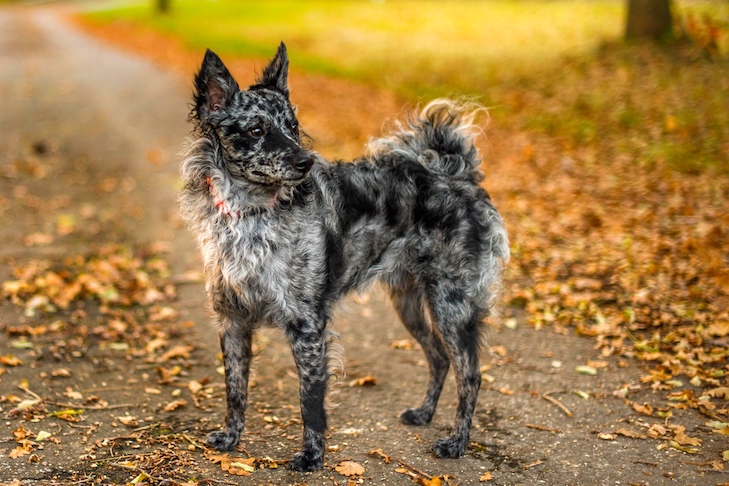
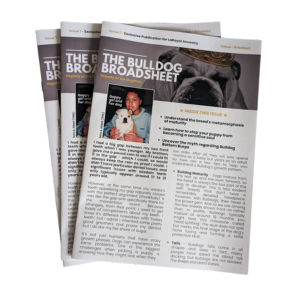
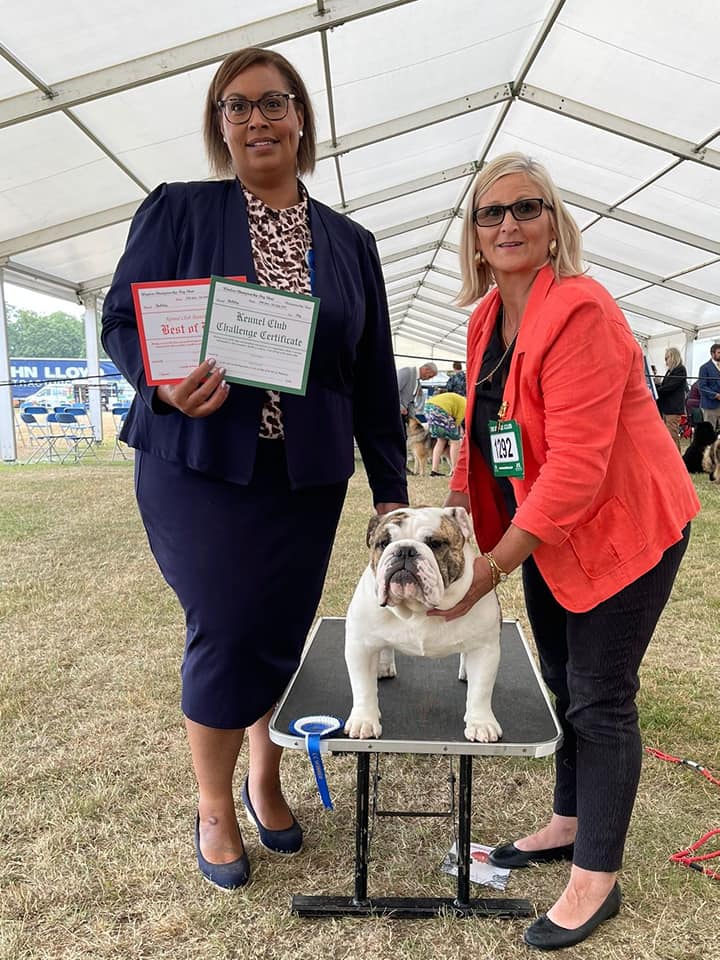
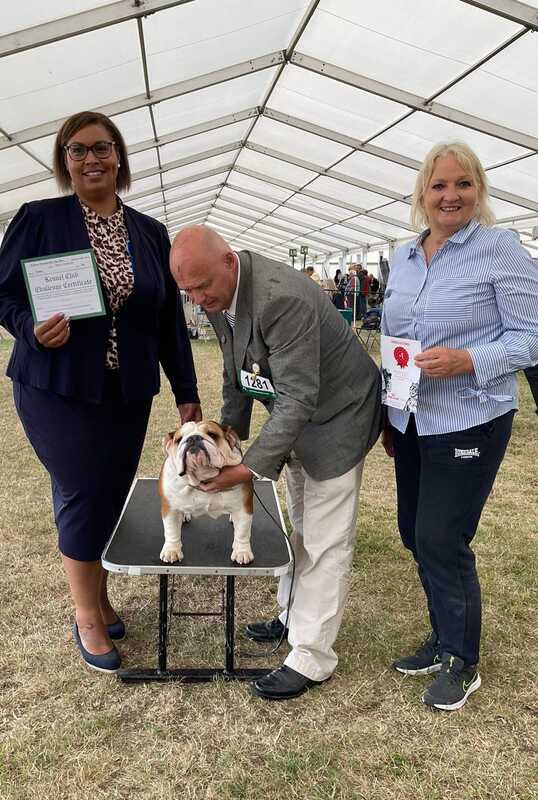

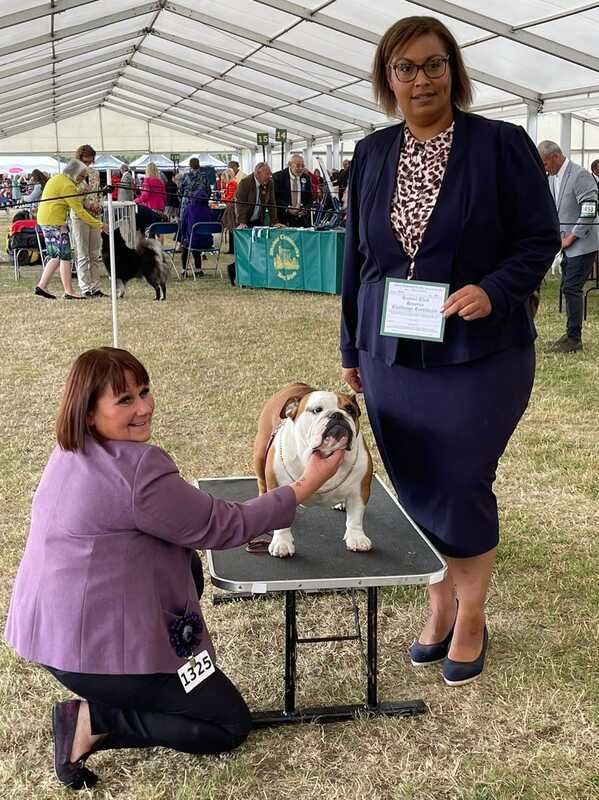

 RSS Feed
RSS Feed
